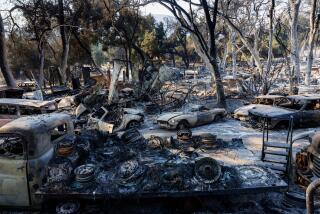Residents remain evacuated as Powerhouse fire spreads to 25,000 acres
Tony Liparote and his family have lived in Elizabeth Lake for 22 years. They’d always counted themselves lucky that brush fires had never chased them from their home.
But that changed Saturday night, when triple-digit temperatures and erratic winds sent the Powerhouse fire careening into Elizabeth Lake and Lake Hughes, two small towns west of Palmdale in northern Los Angeles County.
At 9 p.m. they packed some belongings after a sheriff’s deputy warned residents of a possible evacuation. “At 10:55, we thought we were OK. At 11, we saw the flames come over the ridge and we left,” said Liparote, 57, a supervisor at an aerospace firm. “It was that fast.”
The Liparotes found themselves at the center of an epic battle Saturday night and early Sunday morning, as the fire exploded. The weather conditions produced a chimney effect, in which the winds pulled the flames rapidly through the canyons. Over a 12-hour period, the blaze nearly tripled in size. Firefighters were caught off guard and frantically battled to save the towns, where about 2,800 people were evacuated.
Aided by water-dropping helicopters authorized to fly at night, fire crews on the ground defended structures one by one. Fire personnel from throughout the region streamed into the high desert throughout the night, eventually totalling 2,100.
By sunrise, six structures had been lost but both towns largely survived.
MAP: Evacuation areas, road closures and more
Then, after the weather caused such havoc the night before, on Sunday temperatures cooled and the fire slightly slowed. By afternoon, it had burned 25,000 acres, but evacuations remained in effect, with more possible in the nearby community of Green Valley.
By early evening, the winds had kicked up again and flames from the massive fire leaped from the mountains and raced across the drought-parched high desert plains on the western edge of Lancaster. Helicopters swooped low over the sparsely populated flatlands, bombing hot spots with water.
But Jesse Knox, division supervisor for the U.S. Forest Service, remained optimistic about the effort as temperatures continued to drop. “We expect this fire to lay down” Sunday night, he said. “We are trying to get around it and hem it in.”
The situation was much different Saturday night. Seemingly out of nowhere, the fire cast an eerie glow over the region’s normally tranquil communities, while ash rained onto streets and houses. Power outages added to residents’ confusion and fear.
Nicole Young, 56, of Elizabeth Lake recalled losing electrical power in her home overlooking the water, then having it lighted by the orange glow from flames devouring her 60-foot cottonwoods. “I just laid down on the couch by the living room window and cried,” said the motorcycle shop manager. “It was that scary.”
“We weren’t worrying about it — we thought it was being contained,” said Nicoleta Trifa, 39, of Lake Hughes, who had been spending Saturday evening at the home she shares with friend Sheridan Harris.
At 8 p.m., everything changed.
“The next thing you know, there are helicopters and sheriffs everywhere and [Trifa’s] in the car, screaming at me to come on,” Harris, 52, recalled after the two fled their home.
Not everyone left. Paul Koslo, 70, his wife, Allaire, 50, and daughter Chloe, 15, decided to fight for the Lake Hughes home they have spent 10 years building. On Sunday, as helicopters descended on the lake to pump water for firefighting, Koslo used a small tractor to build a mound of dirt around the house “just in case the fire tries to go over,” he said. Some of their neighbors lost their homes.
On Saturday officials made the unusual call to keep several water-dropping aircraft operating all night despite the dangerous conditions.
Noting that most regions ground aircraft at night, L.A. County Fire Chief Daryl Osby told a news conference Sunday that the aircraft were important in saving houses and other buildings.
“I think this made a significant difference,” Osby said.
One of the most dramatic battles of the fire occurred Saturday night across the street from county Fire Department Station 18 in Lake Hughes, as firefighters managed to save the Painted Turtle, a camp operated by the Paul Newman Foundation for children with serious medical conditions.
County fire engineer Rich Wade first spotted flames boiling over a ridge, headed for the camp, about 4 p.m. Coming from the direction of Green Valley, the flames looked “like a huge blowtorch tossing out embers that were igniting fires a half a mile ahead,” he said.
The 150-acre camp — a collection of classrooms, cabins, an auditorium and recreational facilities — was surrounded by dense brush that had not burned in decades, said Wade, 56, who has spent most of his life in the area.
Yet because the winds had been blowing toward the south for much of the day, he said, firefighters “had left this whole north end alone. There was no staff or strategy in place.”
There were no students in the camp at the time. Roughly 40 staff members left as the flames advanced.
By midnight, “it was a rip-roaring fire and there was a real battle going on here,” said Capt. T.J. Nielsen, of Nielsen’s Fire Protection, a private company.
The fire swept through the area so quickly that local roads were jammed with people in cars scrambling for safety while firefighters battled multiple blazes. Fueling the chaos were downed power lines.
Laboring in dense smoke and near zero visibility, strike teams of firefighters swarmed the camp and, using hand tools and camp fire hydrants, quenched the fire that burned to the very edges of the property on all sides.
There was remarkably little damage to camp buildings.
On Sunday, as temperatures dropped but the threat of strong winds remained, U.S. Forest Service officials closed backcountry roads and trails in the area and ordered the public to stay away. Although the eastern shore of Castaic Lake was affected , the popular waterway remained open for boating.
At an American Red Cross evacuation facility set up at Marie Kerr Park Recreation Center in Palmdale, more than 100 residents awaited word on when they could return home.
Katrina Cimmarrusti, a recreational therapist who lives in Elizabeth Lake, said sheriff’s deputies had knocked on her door about 3 a.m. “‘This is your last chance. The fire is coming right at you,’” Cimmarrusti said they told her.
The power had gone out, so Cimmarrusti grabbed a solar light from her yard and made her way through her house, gathering her four dogs, important documents and two cuckoo clocks her father had given her.
The fire “looked like lava when it came over the ridge,” Cimmarrusti said as she ate an Egg McMuffin under a tree at the evacuation center. “I’ve never seen anything this bad, ever.”
Retiree Jim Simmons said he’s been through dozens of fires in the decades he has lived in Elizabeth Lake, but Sunday was the first time he’d ever evacuated. Shortly after midnight, “I figured it was time to boogie,” he recalled. “This is the first time I’ve seen embers in the street.”
The Sheriff’s Department said mandatory evacuations would remain in effect for at least 24 to 48 hours. The Lake Hughes and Elizabeth Lake evacuations affect about 2,800 people. The approximately 1,000 residents of nearby Green Valley were also under threat of evacuation late Sunday if the fire, which was heading northeast, neared them, officials said.
Three firefighters suffered minor heat-related injuries, officials said. In addition to the six homes destroyed, as many as nine other structures were believed damaged or destroyed, officials said.
The fire remained 20% contained late Sunday. Officials said full containment, originally expected by Wednesday, could be pushed back a day or two, depending on the weather.
Officials do not yet know the cause of the fire, which broke out Thursday near an L.A. Department of Water and Power station in San Francisquito Canyon near Drinkwater Reservoir.
Times staff writers Jean Merl, Christine Mai-Duc, Victoria Kim and Amina Khan contributed to this report.
More to Read
Sign up for Essential California
The most important California stories and recommendations in your inbox every morning.
You may occasionally receive promotional content from the Los Angeles Times.













